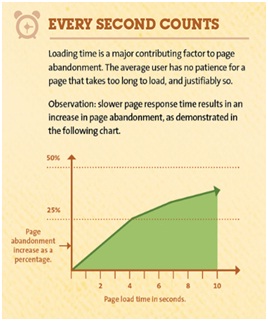We all know the story of the hare and the tortoise. There are many instances when this timely wisdom applies. Unfortunately, it just doesn’t work for the web. The Internet is dynamic. Everything changes quickly. Plus, web users are spoilt for access, speed, and ease of use.
Further, UX/UI have a huge role to play today. Jennifer Cardello of the Neilson Group writes about the age-old scarcity principle, for instance, and why it still holds tremendous value for marketing. The principle primarily works on “loss aversion”.
But if you bring in “aversion” to the way your website looks all the way to how soon your website loads, no principles will work for you. Overall, we are on a losing trail.
Page speed today is an important attribute with benefits spreading out into multiple directions. Just how exactly it’s important and why should you worry about it? Here are the reasons why:
User experience is everything
Today, websites demand speed, ease of navigation, getting the right information, and getting it quick. Meanwhile, they are increasing taking to the mobile to access websites (let’s not even talk about wearables right now).
Surprisingly, most websites are still not responsive. They are not optimized for mobile experiences. And most of them load slowly.
Instead digital design ought to be built for profits. Designing with User intent in mind just makes money. At best, you’d leave people smiling ear to ear.
Design and user experience is a straight-line path to profits. Avinash Kaushik writes:
“
- Rock joy-inducing mobile experiences. Forget mobile first, it’s a mobile only world!
- Deliver fantastic, yet simple, personalization. Don’t wait for perfection.
- Empower customer reviews that are actually helpful. Start stinking less today.
- Design a glorious purchase experience. Take their money, please.
- Convert like a champion! Solve for on-line, off-line, later-line, maybe-line!
- Win with innovative, magnificent, brand experiences. See-Think-Do YouTube.
- Create inspiring, luscious experiences. What if the first interaction with your brand is digital? “
Are you listening?
Slow site speed loses money
We’ll try to plot, condense and focus: No one has time for slow websites, and there are too many options for web users. Marti Trewe of AGBeat.com points to research, which clearly reveals that most slow site speeds are experienced at browser level and the website content itself.
Yet, the infrastructure backing your website is critical. Meanwhile, tolerance levels are slipping continuously. If a website takes 10 seconds to load, more than 50% mobile users abandon a website.
Let’s put that in perspective: Amazon makes about $67 billion in sales per day. A one-second delay drains Amazon of US $ 1.6 billion annually.
There’s a reason why there’s a push for focused web hosting (as against the common shared hosting that most businesses use).
For WordPress, there’s the new Rain Maker.
For Drupal, there’s HudHosting.
Meanwhile there are tons of independent CDN systems such as Amazon’s Cloud Front, CloudFlare and MaxCDN and a mind-boggling number of plugins, tools, and even specialist vendors to fine-tune your website speed.
Site speed impacts search rank
For businesses all over the world that have anything to do with a website, organic search is still a major traffic source. While it’s a matter of huge speculation as to what factors contribute to better search rankings on Google, for instance, a few things are intuitively obvious.
Google pays a lot of emphasis on user experience, content relevancy, and content quality. But talk about user experience, and site speed immediately becomes an important aspect to consider.
Zoompf’s post on Moz.com, goes for a deep dive on the correlation of search rankings and various parameters such as page load time, time to first byte, page size, and image content.
The conclusion is this: a website’s back-end infrastructure has a direct correlation with search rank. Meanwhile, all the test attributes are important.
Site speed affects your bottom line
Now, your bottom-line depends on a lot of factors, of course. We are, however, only writing about your website’s contribution to your bottom-line and all those things you do to drive traffic, conversions, and sales for your business.
Benjamin Spiegel of Marketing Land listed out why you need improve your page speed and a few things that the page load time affects are user experience, Google Ad Words quality score, and of course, your organic search rankings.
An Infographic from KissMetrics reveals how every second of page load speed counts.
- If you are running an ecommerce store or even if you were to just consider drop-offs on your web pages, every second adds to the abandonment rate.
- Page speed affects mobile users’ behavior drastically. Mobile users aren’t going to visit you again if your website takes forever to load.
- Speed has a direct correlation to users’ shopping behavior
Underperforming websites lose customers forever
Shopify pulled in data from Statista and WorldPay and it was found that many typical factors attributed to a high abandonment rate of about 67%.
A good percentage of customers, however, left the store because of under performing websites. Roughly 24% of customers left because the website crashed. Another 25% left because the navigation was too complicated. Just because ecommerce stores had too many payment security checks, another 18% left the store. Process taking too long, website time-out led to another 21% and 15% respectively.
If you had an ecommerce store, all those abandonment instances cost you money directly. If you don’t fix your website, this drain in your bottom-line will continue.
How fast does your website load? Is slow site speed already beginning to affect your business? Are you an ecommerce store that’s losing sales and customers by every second of delay?
Share your experiences with us.













